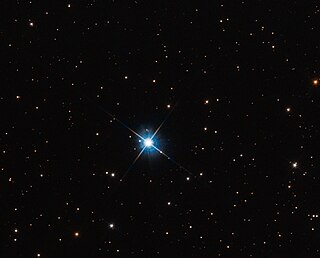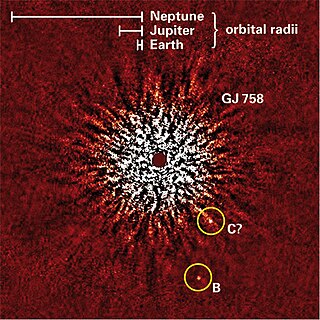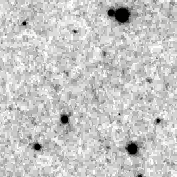
40 Eridani is a triple star system in the constellation of Eridanus, abbreviated 40 Eri. It has the Bayer designation Omicron2 Eridani, which is Latinized from ο2 Eridani and abbreviated Omicron2 Eri or ο2 Eri. Based on parallax measurements taken by the Gaia mission, it is about 16.3 light-years from the Sun.
HD 168443 is an ordinary yellow-hued star in the Serpens Cauda segment of the equatorial constellation of Serpens. It is known to have two substellar companions. With an apparent visual magnitude of 6.92, the star lies just below the nominal lower brightness limit of visibility to the normal human eye. This system is located at a distance of 127 light years from the Sun based on parallax, but is drifting closer with a radial velocity of −48.7 km/s.
HD 38529 is a binary star approximately 138 light-years away in the constellation of Orion.
HD 142 is a wide binary star system in the southern constellation of Phoenix. The main component has a yellow-white hue and is dimly visible to the naked eye with an apparent visual magnitude of 5.7. The system is located at a distance of 85.5 light years from the Sun based on parallax measurements, and is drifting further away with a radial velocity of +6 km/s.
HD 50281 is a star in the equatorial constellation of Monoceros. It is orange in hue with an apparent visual magnitude of 6.58, which lies at or below the typical limit of visibility to the naked eye. The star is located at a distance of 28.5 light years from the Sun based on parallax, but is drifting closer with a radial velocity of −7.2 km/s.
HR 4458 is a binary star system in the equatorial constellation of Hydra. It has the Gould designation 289 G. Hydrae; HR 4458 is the Bright Star Catalogue designation. At a distance of 31.13 light years, it is the closest star system to the Solar System within this constellation. This object is visible to the naked eye as a dim, orange-hued star with an apparent visual magnitude of 5.97. It is moving closer to the Earth with a heliocentric radial velocity of −22 km/s.

Gliese 440, also known as LP 145-141 or LAWD 37, is an isolated white dwarf located 15.1 light-years from the Solar System in the constellation Musca. According to a 2009 paper, it is the fourth closest known white dwarf to the Sun
Gliese 412 is a pair of stars that share a common proper motion through space and are thought to form a binary star system. The pair have an angular separation of 31.4″ at a position angle of 126.1°. They are located 15.8 light-years distant from the Sun in the constellation Ursa Major. Both components are relatively dim red dwarf stars.
Gliese 86 is a K-type main-sequence star approximately 35 light-years away in the constellation of Eridanus. It has been confirmed that a white dwarf orbits the primary star. In 1998 the European Southern Observatory announced that an extrasolar planet was orbiting the star.
HD 111232 is a star in the southern constellation of Musca. It is too faint to be visible with the naked eye, having an apparent visual magnitude of 7.59. The distance to this star is 94.5 light years based on parallax. It is drifting away from the Sun with a radial velocity of +104 km/s, having come to within 14.1 light-years some 264,700 years ago. The absolute magnitude of this star is 5.25, indicating it would have been visible to the naked eye at that time.
HD 164427 is a star with a likely red dwarf companion in the southern constellation of Pavo. It has an apparent visual magnitude of 6.88, placing it just below the nominal limit for visibility with the typical naked eye. The annual parallax shift of 23.5 mas yields a distance estimate of 139 light-years. It is moving further from the Earth with a heliocentric radial velocity of +3.4 km/s.
HD 115404 is a binary star system located in the constellation Coma Berenices. Parallax measurements made by Hipparcos put the system at 36 light-years, or 11 parsecs, away. The combined apparent magnitude of the system is 6.52, with the magnitudes of the components being 6.66 and 9.50.
36 Ursae Majoris is a double star in the northern constellation of Ursa Major. With an apparent visual magnitude of 4.8, it can be seen with the naked eye in suitable dark skies. Based upon parallax measurements, this binary lies at a distance of 42 light-years from Earth.
BD+14 4559 is a star with an exoplanetary companion in the northern constellation of Pegasus. During the 2019 NameExoWorlds campaign, the star was named Solaris by Poland after a 1961 science fiction novel about an ocean-covered exoplanet by Polish writer Stanisław Lem. With an apparent visual magnitude of 9.78, the star is too faint to be viewed with the naked eye. The system is located at a distance of 161 light-years from the Sun based on parallax measurements, but is drifting closer with a radial velocity of −44 km/s. It is a high proper motion star, traversing the celestial sphere at an angular rate of 0.234″ yr−1.

Gliese 758 is a star in the northern constellation of Lyra. At about magnitude 6 it is a challenge to view with the naked eye even in good seeing conditions, but can be easily seen through a small telescope or binoculars. Parallax measurements from the Hipparcos mission give it an estimated distance of around 50.9 light-years from Earth.
HD 126614 is a trinary star system in the equatorial constellation of Virgo. The primary member, designated component A, is host to an exoplanetary companion. With an apparent visual magnitude of 8.81, it is too faint to be seen with the naked eye. The system is located at a distance of 239 light years from the Sun based on parallax measurements, but is drifting closer with a radial velocity of −33 km/s.
HD 81817 is a possible binary star system with two brown dwarf companions in the northern circumpolar constellation of Draco. It has an orange hue and is visible to the naked eye with an apparent visual magnitude of 4.28. The system is located at a distance of approximately 990 light years from the Sun based on parallax, and is drifting closer with a radial velocity of −7 km/s. It is a member of the IC 2391 moving group.
HD 16754 is a binary or triple-star system in the constellation Eridanus. It has the Bayer designation s Eridani; HD 16754 is the designation from the Henry Draper catalogue. The system is visible to the naked eye as a faint point of light with an apparent visual magnitude of +4.74. It is located at a distance of approximately 132 light years from the Sun based on parallax, and is drifting further away with a radial velocity of +18 km/s. The system is a member of the Columba association of co-moving stars.
HD 167665 is a yellow-white hued star with a brown dwarf companion in the southern constellation of Sagittarius. With an apparent visual magnitude of 6.39, it is near the lower brightness limit for stars that are visible to the naked eye. Based upon an annual parallax shift of 32.4 mas as seen from Earth, it is located 101 light years from the Sun. The star is moving away from the Sun with a radial velocity of +8 km/s.
HD 72945 and HD 72946 form a co-moving star system in the northern constellation of Cancer. HD 72945 is a binary star that is dimly visible to the naked eye as a point of light with an apparent visual magnitude of 5.91. At an angular separation of 10.10″ is the fainter companion star HD 72946 at magnitude 7.25. It is being orbited by a brown dwarf. The system as a whole is located at a distance of approximately 84 light years from the Sun based on parallax measurements.




